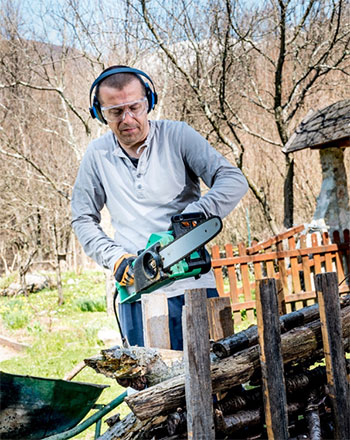How to use the Chainsaw Safely
Story by Helen McMenamin
Regular maintenance, at least every day you're working with a saw, is Bissell's mantra. Sharpening the chain every day (even twice a day for some work) and holding at the correct blade angle is working smart, she says.
Husqvarna has some helpful YouTube videos showing the correct sharpening techniques. Bissell recommends the Husqvarna guide tool to help you get the right blade angle for your saw, as well as the right height for the rakers that control the amount of timber your chain must cut through. She and other Husqvarna technicians are always ready to show you the right tools and help you ensure you have the right technique for sharpening your chain.

Blade angle and wood type affect the size of wood chips the saw kicks out. If it's fine sawdust, it can block the air filter, so check it - you may need to wash it often. The air filter can be so clogged the engine stalls, or sawdust can get into the carburetor and clog all the little passageways.
Regular maintenance is essential to keep your saw working up to its full capacity, so it performs as you expect, says Bissell. Make sure your bar is clean. Starting at the sprocket, scrape oil towards the chain and clean the oil ports. If you can't get clear the ports, you can give them a squirt of brake fluid. Clean the groove where the chain runs, so the oil can reach the chain. It runs at more than 8,000 rpm with the bar at 100°C, so keeping oil in all the right places is vital. Make sure the chain is tightened correctly. If you're not sure how to do routine maintenance, talk to a technician and have them show you the right tension and the best way to do each step.
The other part of chainsaw maintenance (and the thing that's most often ignored) is to measure the 50:1 gas/oil 2-stroke fuel mix as accurately as possible. It's the most common problem that Bissell and her fellow small engine technicians see. It leads to poor performance and saws not lasting nearly as long as they should.
Husqvarna has its own ready-to-use fuel. The company is so convinced of the importance of properly-mixed good quality fuel to performance and longevity that the warranty period is extended by a year for buyers of three cans of their fuel.
With your saw maintenance done, it's time for you to get ready for work. At the absolute minimum, PPE (personal protective equipment) includes chaps, gloves, boots, and eye protection. Bissell would prefer to see everyone with a chainsaw also using ear protection, a mesh or plexiglass face shield, and a jacket as well.
"Husqvarna has done amazing things with their clothing," she says. "I've seen a couple of chains derail, and they're scary - the chain is traveling at over 80 feet per second. The Husqvarna jacket catches the chain and stalls the saw." Rather than working through a heavyweight fabric, the jacket has cut-retardant pads that reduce the severity of injury, because they're designed to rip apart when they come into contact with a moving chain, and to clog the sprocket and stop the chain within a fraction of a second."
Bissell has one last piece of advice. "Talk to a professional before you buy a saw, so you can pick the right one for you and get some safety tips."